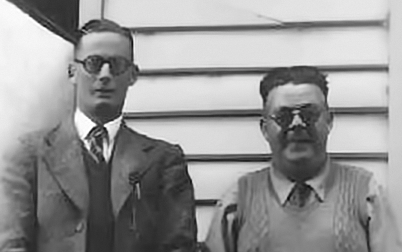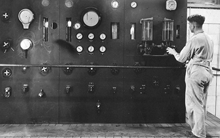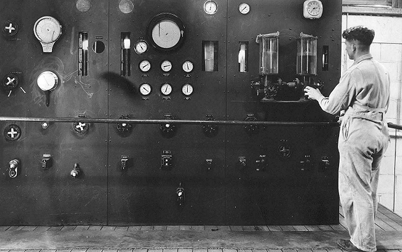|
1952 Vintage Crush 19,950 tons
Allocation was 6,094 tons to Wine and 13,856 tons to Spirit, 30.55%
Average Baume 12.91°
This vintage was to be a great experience for me and I will try and recall as much as I can.
All Dry White and Red wines were fermented in No.1 Cellar. The maximum use was made of the Run-Off tanks with cooling coils. When the major part of the fermentation was finished the various wine s would be transferred to Block 3 Tanks. Here, the final degree or two of Baume would ferment out and when completed a thin layer of paraffin oil would be poured onto the surface. The combination of grape solids and dead yeast cells would be allowed to settle. A descending sample would then be taken after 7-10 days and if the solids, called gross lees, had settled, the wine would be pumped with a hose introduced into the top level of the wine and gradually lowered down until the suction was beginning to include some materiel from the lees layer. This method was introduced after it was decided to blank off the bottom bronze valve outlet. This was a source of metal contamination. To see this level of the hose suction the cellar hand used a light on an extension lead. The gross lees volume would average between five to ten percent of the contents. The lees would consist of skins, seeds, sand and yeast cells. These lees would then be pumped to No.3 cellar Tanks and await distillation.
For the fortified wine manufacture the juice from the must in Ferment Cellars No.1 and 2 could be transferred to Blocks 3, 4, 6 and 7. For the manufacture of fortified sweet wine a number of tanks would have pumped to them, say 2,000 gallons of fermenting grape juice and then the full compliment of fortifying spirit would be added and the tanks would have fermenting grape juice progressively pumped in over the next two to three days. As with the procedure for the Table wines the tank contents would be allowed to settle. Given that a safe balance of Baume, Alcohol and SO2 levels existed, these wines were stable and resistant to spoilage conditions unlike Table Wines. The gross lees from these wines would likewise be racked to a convenient nearby tank and when that was full, the contents would be allowed to settle for another period in order to limit the amount of lees wine that would have to be fermented and distilled. Once the clear wine had settled and been racked off, the consolidated lees would be pumped to the No. 3 Cellar tanks and there fermented and distilled and the product distinguished as lees fortifying spirit. The resultant spirit had quite a different odour and flavour content due to a high degree of esters and sulphur compounds and was best used to top up the more flavoursome Muscat Gordo Blanco wine.
Brian Barry joined the Company as Assistant Winemaker in July 1952. Brian achieved his Diploma of Oenology at Roseworthy in 1947 and had spent 4 years with Hamilton's Ewell Winery as Winemaker.
 
|
Leaving the Company on July 30th Alec Kelly was appointed General Manager of the Loxton Cooperative Winery and Distillery in August.
The photo here is Alec Kelly(left) and Ray Harrip(right) in front of the Bond Office prior to Alec's departure.
|
 
|
George Rowe commenced as a distiller and is pictured here at the control panel of the Blair Still.
|
The next major event was my receipt of notice that I was to enlist in the 2nd Intake of the National Service. The Army training was for a period of 3 months. Doug. Collett said I could not be spared for the 6 month period in either the Air Force or Navy. So the Army it was at Woodside Barracks from August to October.
Electricity Trust of South Australia installed a high voltage supply to the Berri central sub-station.
This year saw installed a new Wine Sales Store at the east end of the Main Cellar, an Amenity Block, the conversion of two grape mills to a bin screw section, a concrete loading bay and ramp at the Bond Store, Refrigerated Chiller Tanks 1 & 2, the conversion of the Electrical plant from Direct to Alternating current, two 6,000 gallon Brandy Vats, Weighscale for the Bond Store, and a Stalk Conveyor for No. 1 Ferment Cellar.
A decision was made to establish a sales outlet at the front of the winery rather than customers wandering right around the back of the Main Cellar. Jack Mutton's office had been above underground tanks 801-803. So a decision was made and Tom Kennedy, who had spent many years in the Bond Store, was placed in charge. Tom was a very bright and cheerful person who made everybody welcome. He had the quirky Irish humour together with his very quick wit, and did a marvelous job looking after the customers until his death in December 1959. |









